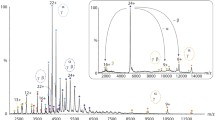Abstract
A large class of arthropod transcription factors is formed by proteins with a characteristic N-terminal Zinc-finger-Associated Domain (ZAD) which contains four cysteine residues that coordinate a zinc ion. The number of putative proteins with ZAD in the Drosophila genome exceeds 90, and the degree of sequence similarity between these domains can be as low as 23%. Efficient binding of ZADs from the proteins Grau, ZIPIC, and Zw5 to the translation elongation factor EF1α1 in nuclear and cytoplasmic extracts has been demonstrated. EF1α1 is probably involved in the regulation of the activity of ZAD-containing transcription factors.
Similar content being viewed by others
Abbreviations
- ZAD:
-
Zinc-finger-Associated Domain
- GST:
-
glutathione-S-transferase
References
Chung H.R., Schafer U., Jackle H., Bohm S. 2002. Genomic expansion and clustering of ZAD-containing C2H2 zinc-finger genes in Drosophila. EMBO Rep. 3, 1158–1162.
Chung H.R., Lohr U., Jackle H. 2007. Lineage-specific expansion of the zinc finger associated domain ZAD. Mol. Biol. Evol. 24, 1934–1943.
Razin S.V. Borunova V.V., Maksimenko O.G., Kantidze O.L. 2012. Cys2His2 zinc finger protein family: Classification, functions, and major members. Biochemistry (Moscow). 77 (3): 217–226.
Jauch R., Bourenkov G.P., Chung H.R., Urlaub H., Reidt U., Jackle H., Wahl M.C. 2003. The zinc fingerassociated domain of the Drosophila transcription factor grauzone is a novel zinc-coordinating protein–protein interaction module. Structure. 11, 1393–1402.
Payre F., Buono P., Vanzo N., Vincent A. 1997. Two types of zinc fingers are required for dimerization of the serendipity delta transcriptional activator. Mol. Cell Biol. 17, 3137–3145.
Chen L.Y., Wang J.C., Hyvert Y., Lin H.P., Perrimon N., Imler J.L., Hsu J.C. 2006. Weckle is a zinc finger adaptor of the toll pathway in dorsoventral patterning of the Drosophila embryo. Curr. Biol. 16, 1183–1193.
Maksimenko O., Bartkuhn M., Stakhov V., Herold M., Zolotarev N., Jox T., Buxa M.K., Kirsch R., Bonchuk A., Fedotova A., Kyrchanova O., Renkawitz R., Georgiev P. 2015. Two new insulator proteins, Pita and ZIPIC, target CP190 to chromatin. Genome Res. 25, 89–99.
Schwartz Y.B., Linder-Basso D., Kharchenko P.V., Tolstorukov M.Y., Kim M., Li H.B., Gorchakov A.A., Minoda A., Shanower G., Alekseyenko A.A., Riddle N.C., Jung Y.L., Gu T., Plachetka A., Elgin S.C., Kuroda M.I., Park P.J., et al. 2012. Nature and function of insulator protein binding sites in the Drosophila genome. Genome Res. 22, 2188–2198.
Gaszner M., Vazquez J., Schedl P. 1999. The Zw5 protein, a component of the scs chromatin domain boundary, is able to block enhancer–promoter interaction. Genes Dev. 13, 2098–2107.
Kyrchanova O., Georgiev P. 2014. Chromatin insulators and long-distance interactions in Drosophila. FEBS Lett. 588, 8–14.
Chetverina D., Aoki T., Erokhin M., Georgiev P., Schedl P. 2014. Making connections: Insulators organize eukaryotic chromosomes into independent cisregulatory networks. Bioessays. 36, 163–172.
Kyrchanova O., Chetverina D., Maksimenko O., Kullyev A., Georgiev P. 2008. Orientation-dependent interaction between Drosophila insulators is a property of this class of regulatory elements. Nucleic Acids Res. 36, 7019–7028.
Maksimenko O., Georgiev P. 2014. Mechanisms and proteins involved in long-distance interactions. Front. Genet. 5, 28.
Graham P.L., Yanowitz J.L., Penn J.K., Deshpande G., Schedl P. 2011. The translation initiation factor eIF4E regulates the sex-specific expression of the master switch gene Sxl in Drosophila melanogaster. PLoS Genet. 7, e1002185.
Vera M., Pani B., Griffiths L.A., Muchardt C., Abbott C.M., Singer R.H., Nudler E. 2014. The translation elongation factor eEF1A1 couples transcription to translation during heat shock response. Elife. 3, e03164.
Hernandez G., Proud C.G., Preiss T., Parsyan A. 2012. On the diversification of the translation apparatus across eukaryotes. Comp. Funct. Genomics. 2012, 256848.
Abbas W., Kumar A., Herbein G. 2015. The eEF1A proteins: At the crossroads of oncogenesis, apoptosis, and viral infections. Front. Oncol. 5, 75.
Liu G., Grant W.M., Persky D., Latham V.M., Singer R.H., Condeelis J. 2002. Interactions of elongation factor 1alpha with F-actin and beta-actin mRNA: Implications for anchoring mRNA in cell protrusions. Mol. Biol. Cell. 13, 579–592.
Author information
Authors and Affiliations
Corresponding author
Additional information
Original Russian Text © N.A. Zolotarev, O.G. Maksimenko, Yu.V. Shidlovskii, P.G. Georgiev, A.N. Bonchuk, 2016, published in Molekulyarnaya Biologiya, 2016, Vol. 50, No. 6, pp. 1014–1019.
Rights and permissions
About this article
Cite this article
Zolotarev, N.A., Maksimenko, O.G., Shidlovskii, Y.V. et al. Translation elongation factor EF1α1 interacts with ZAD domains of transcription factors from Drosophila melanogaster . Mol Biol 50, 895–899 (2016). https://doi.org/10.1134/S002689331606025X
Received:
Accepted:
Published:
Issue Date:
DOI: https://doi.org/10.1134/S002689331606025X




